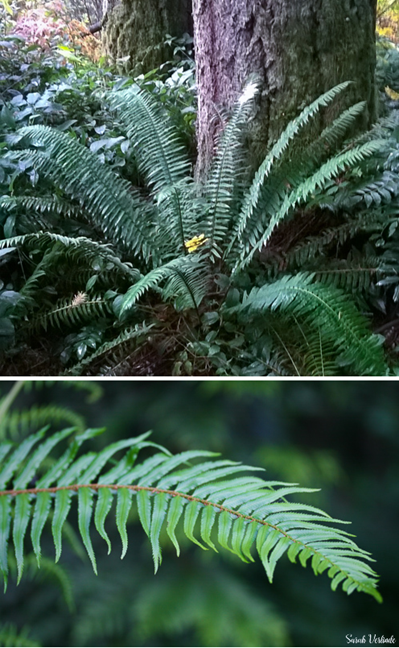Sword fern
Polystichum munitum – Sword fern
At a Glance:

- Family: Dryopteridaceae
- Plant Type: Basal evergreen fern
- Distribution: Primarily western North America, as far east as Montana
- Habitat: Woods and open areas at low to mid-elevations. Shade is ideal. It does well cultivated in gardens.
- Height: 2-5 feet
- Spores: reproductive spores are gold-red-brown and appear on the underside of leaf fronds year round
- Leaves: bright to dark green, leathery fronds on upper side of the leaf (frond), with a papery, lighter green underside. One frond is made of many leaflets, 0.4-6 inches long. Many fronds can grow from the center (75-100 leaves) creating a crown.
- Generation: Perennial, some leaves die back every year during the fall, but maintains at least half through the winter.
- Notable feature: Fiddleheads are immature leaves/fronds and unfurl in spring. They are covered in fine silky brown hairs.
Restoration and Conservation
Many mammals rely on sword fern throughout Washington State. Elk, black-tailed deer, mountain beavers, mountain goats, and black bears eat the fronds (leaves). Sword ferns provide nesting and cover for many birds, deer, and small mammals. Black bears will even collect fronds and use them for bedding in dens for winter hibernation.
Ethnobotany/Commercial Use
Northwest coastal tribes used sword fern leaves to line fire pits for cooking, and line baskets and drying racks. The rhizomes could be eaten by peeling and then steaming or roasting them. The leaves and/or stems could be made into tea for certain maladies.
Sword fern is an important landscaping plant and easy to find in most nurseries for home gardening. It is also grown and harvested extensively for foliage in the fresh floral industry.
References and Resources
- FEIS/USDA: https://www.fs.fed.us/database/feis/plants/fern/polmun/all.html
- WTU Image Herbarium: http://biology.burke.washington.edu/herbarium/imagecollection/taxon.php?Taxon=Polystichum%20munitum
This article was written by Sarah Verlinde. For questions regarding the UWB/CC Plant Tour, contact Sarah at severlin@uw.edu.
